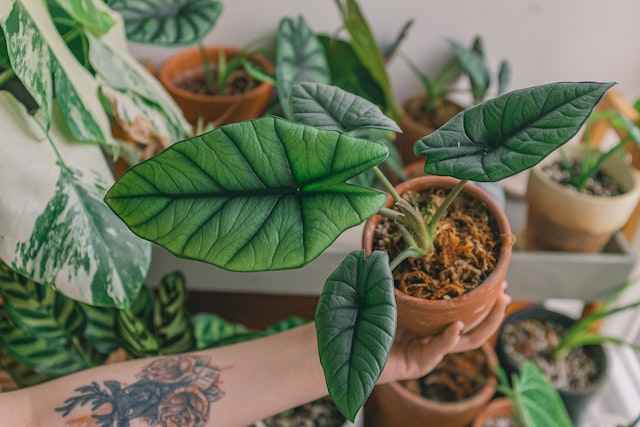How to grow and care for Alocasia Polly: Alocasia polly, also known as the African Mask Plant, is a stunning tropical plant that is well known for its large, glossy leaves that resemble the face of an African mask. It’s native to Southeast Asia and has become a popular indoor plant for homes and offices due to its striking appearance and ease of care.
How to grow and care for Alocasia Polly
If you’re looking to grow your own Alocasia polly, here’s what you need to know:
Light
Alocasia polly thrives in bright, indirect light but can also tolerate some shade. Place your plant near a bright window but out of direct sunlight, which can scorch the leaves. If your plant is not getting enough light, its leaves will become smaller and less glossy.
Water
Alocasia polly likes to be kept consistently moist but not waterlogged. The soil should be damp, but not soaking wet, and the plant should be allowed to dry out slightly between waterings. Overwatering can lead to root rot, so make sure the soil is well-draining.
Humidity
Alocasia polly loves high humidity and will thrive in a humid environment. If you live in a dry climate, you can increase humidity levels by placing a humidifier near your plant or by placing a tray of water near it.
Temperature
Alocasia polly prefers warm temperatures between 70 and 90 degrees Fahrenheit. Keep it away from cold drafts, and avoid exposing it to temperatures below 50 degrees Fahrenheit.
Soil
Alocasia polly prefers a well-draining, fertile soil mix. A mixture of peat moss, perlite, and potting soil works well. Make sure the soil is consistently moist but not waterlogged.
Fertilizer
Alocasia polly benefits from regular fertilization. Use a balanced, all-purpose fertilizer every two to four weeks during the growing season. Be sure to follow the instructions on the fertilizer package and avoid over-fertilizing, which can lead to leaf burn.
Pruning
Prune your Alocasia polly regularly to maintain its shape and encourage healthy growth. Cut back yellowing or damaged leaves to the base of the plant and remove any dead or diseased foliage.
Pests and Diseases
Alocasia polly is susceptible to a few common indoor plant pests, including spider mites and mealybugs. Regularly inspect your plant for signs of infestation and treat as needed. Root rot can also be a problem if the soil is too wet or if the plant is overwatered.
Read this also:
If we tell in brief, Alocasia polly is a beautiful and relatively low-maintenance indoor plant that makes a stunning addition to any home or office. By following these care tips, you can keep your Alocasia polly healthy and thriving for years to come.
